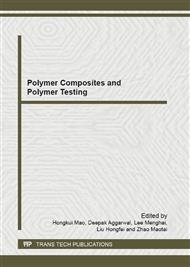p.20
p.25
p.31
p.35
p.40
p.44
p.49
p.53
p.58
Investigation of Structure and Properties of PET Multifilament Irradiated with UV in Different Atmosphere
Abstract:
Changes of mechanical properties and chemical structure of polyester (PET) fibers are studied through UV simulated accelerated ageing experiments with N2, air and O3 as the atmosphere. The structure, thermal stabilities and tensile strength are obtained by FTIR, DTA-TG, XRD, SEM and micro-mechanics test. The difference of degradation process in various atmospheres is discussed in this paper. The results show that the fracture tensile strength of PET multifilament decreases with the increase of UV irradiation time. And oxidation and then decarbonylation take place on the surface. Besides, Melting temperature (Tm), the temperature of quality loss by 10% (T10) and the crystallization also decrease. However, in O3 atmosphere the oxidation develops very quickly and fully, therefore, the carbonyl on the surface is eliminated and decreases significantly, and the tensile strength decreases much faster than those in N2 and air. The skin layer of irradiated fibers appears serious damaged. The mechanism of chemical degradation for samples irradiated in N2 environments is similar to those irradiated in air.
Info:
Periodical:
Pages:
40-43
Citation:
Online since:
April 2012
Authors:
Price:
Сopyright:
© 2012 Trans Tech Publications Ltd. All Rights Reserved
Share:
Citation:


